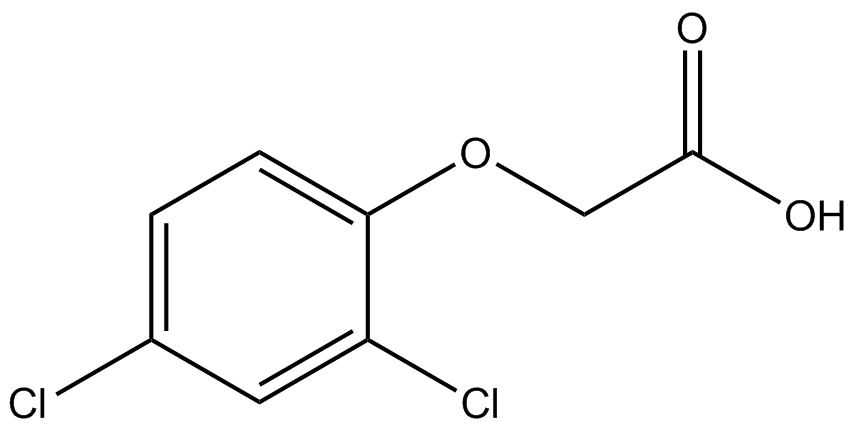Introduction
Description:
2,4-Dichlorophenoxyacetic acid being an auxin can support embryogenesis and callus formation at low concentrations, and have herbicidal activity at high concentrations, 2,4-D
| Solubility |
Water |
| Physical Form |
Liquid |
| Concentration |
10 mg/mL |
| Sterility |
Sterile Filtered |
| Storage Temp. |
2 to 6 °C |
| Other Notes |
Plant Tissue Culture Tested |
| UPC / SKU |
D309 |
| CAS NUMBER |
94-75-7 |
| Formula Weight |
221.04 |
| Formula |
C8H6Cl2O3 |
| Storage Temp. |
2 to 6 °C |
| Tariff Code |
2918.90.4700 |
| Risk Info (R) |
22-37-41-43 |
| Safety Info (S) |
24/25-36/37/39-46 |
No information available
D309 2,4-Dichlorophenoxyacetic Acid Solution (10 mg/mL)
| Synonyms: |
2,4-D |
| CAS: |
94-75-7 |
| Formula: |
C8H6Cl2O3 |
| Molecular Wt: |
221.04 |
| Properties |
|---|
| Form: |
Liquid |
| Appearance: |
Colorless, Clear Liquid |
| Application: |
Plant Growth Regulator; Auxin |
| Solubility: |
Miscible with Water |
| Typical Working Concentration: |
Varies with application, should be determined by the end user. |
| Storage Temp: |
2 to 6 °C |
| Other Notes: |
Plant Tissue Culture Tested; For Research Use Only |
Application Notes
2,4-D has similar mode of actions to other auxins, e.g., adventitious root formation, induction of somatic embryos, cell division, callus formation and growth, inhibition of axillary buds, inhibition of root elongation.
Typical working concentration of 2,4-D ia varied by application and plant species. It has been reported that soybean treated with 2,4-D at concentrations between 5.0 and 10 mg/L stimulated callus growth, while at a much lower concentration such as 0.5 mg/L stimulated new cell formation and cellular enlargement for tobacco callus tissue. 2 Other concentration such as 1-3 mg/L of 2,4-D has been reported to be effective in inducing callus formation of broad-leaf plants. 3 Additionally, 2,4-D is often used together with IAA and L-tryptophan for callus induction and suspension cultures of wheat, pearl millet and rice. 4 2,4-D has also been used in seed testing for the detection of Phoma lingam on Brassica spp when incubated on a blotting paper that has been soaked with 0.2% 2,4-D solution.
PhytoTechnology Laboratories® also carries 2,4-Dichlorophenoxyacetic Acid Solution (1 mg/mL), Product No. D295.
Please Note: While PhytoTechnology Laboratories™ tests each lot of this product with two or more plant cell/ tissue culture lines, it is the sole responsibility of the purchaser to determine the appropriateness of this product for the specific plants that are being cultured and applications that are being used.
References
1. Merck 13, 2825
2. Bukowska, B. 2006. Toxicity of 2,4-dichlorophenoxyacetic acid – molecular mechanisms. Polish J. of Environ. Stud. 15(3):265-374.
3. Witham, Francis H. 1968. Effect of 2,4-dichlorophenoxyacetic acid on the cytokinin requirement of soybean cotyledon and tobacco stem pith callus tissues. Plant Physiol. 43:1455-1457.
4. George, E.F. 1993. Plant propagation by tissue culture. Part 1: The Technology, 2nd Ed. Exegetics Ltd. Edington, Wilts. BA13 4QG, England.
5. The International Seed Testing Association (ISTA). International Rules for Seed Testing ed. 2012. Annexe to Chapter 7 Seed Health Testing: Seed Health Testing Methods. Bassersdorf, Switzerland.




